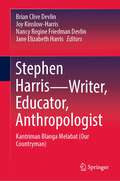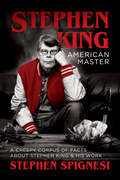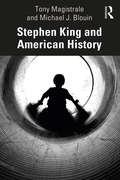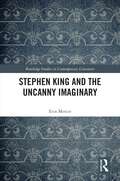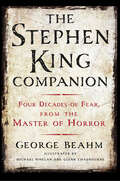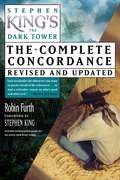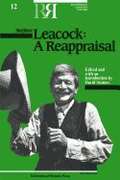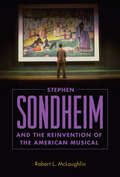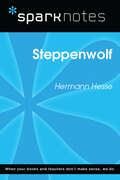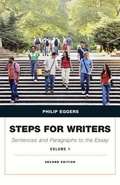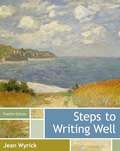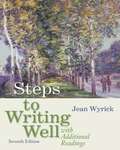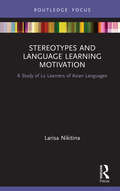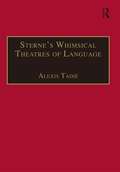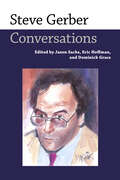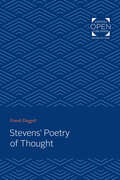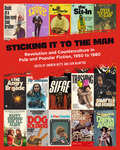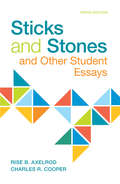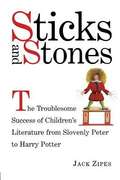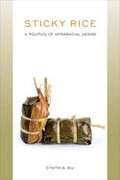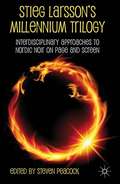- Table View
- List View
Stephen Harris—Writer, Educator, Anthropologist: Kantriman Blanga Melabat (Our Countryman)
by Brian Clive Devlin Joy Kinslow-Harris Nancy Regine Friedman Devlin Jane Elizabeth HarrisThis book documents the impact of Stephen Harris’s works in Aboriginal education, Aboriginal learning styles, domains of language use and bilingual-bicultural education. It provides a summary and critique of Stephen Harris's key ideas, particularly those on bilingual-bicultural education. This book also profiles the man, his background, his beliefs and talents. It showcases contributions and personal reflections from Stephen’s family, wife, close colleagues, and many of those influenced by his work. This festschrift explores the professional life and work of Stephen Harris as an educator and anthropologist who worked in the Northern Territory of Australia.
Stephen King: The Art of Darkness
by Douglas E. WinterI first met Stephen King in a shoeshine parlor. It was like finding a Woodrow Wilson dime or a Maine roadmap with a town named Jerusalem's Lot. It was like ...well, it was like a story by Stephen King.
Stephen King, American Master: A Creepy Corpus of Facts About Stephen King & His Work
by Stephen SpignesiFascinating facts, trivia, and little-known details about the Master of the Macabre’s life from the “world’s leading authority on Stephen King” (Entertainment Weekly).New York Times–bestselling author Stephen Spignesi has compiled interviews, essays, and loads of facts and details about all of Stephen King’s work into this fun and informative compendium for the author’s many fans, from the casual to the fanatical!Did you know. . . ? In his early teens, Stephen King sold typed copies of his short stories at school.King originally thought his novel Pet Sematary was too frightening to publish.King’s legendary Dark Tower series took him more than 30 years to write.Thinner was the novel that revealed his “Richard Bachman” pseudonym to the world.King wrote The Eyes of the Dragon for his daughter Naomi.He has never liked Stanley Kubrick’s film version of his novel The Shining.It took him four years to write what some consider his magnum opus, IT.The 2017 film version of IT has grossed more than $700 million worldwide.In addition to novels, King has written essays, plays, screenplays, and even poetry.
Stephen King and American History
by Tony Magistrale Michael J. BlouinThis book surveys the labyrinthine relationship between Stephen King and American History. By depicting American History as a doomed cycle of greed and violence, King poses a number of important questions: who gets to make history, what gets left out, how one understands one's role within it, and how one might avoid repeating mistakes of the past. This volume examines King's relationship to American History through the illumination of metanarratives, adaptations, "queer" and alternative historical lenses, which confront the destructive patterns of our past as well as our capacity to imagine a different future. Stephen King and American History will present readers with an opportunity to place popular culture in conversation with the pressing issues of our day. If we hope to imagine a different path forward, we will need to come to terms with this enclosure—a task for which King's corpus is uniquely well-suited.
Stephen King and the Uncanny Imaginary (Routledge Studies in Contemporary Literature)
by Erin MercerOffering an insightful examination of Stephen King’s fiction, this book utilises a psychoanalytical approach drawing on Freud’s theory of the uncanny. It demonstrates how entrenched King’s work is in a literary tradition influenced by psychoanalytic theory, as well as the ways that King evades and amends Freud. Such an approach positions King’s texts not simply as objects of interpretation that might yield latent meaning, but as producers of meaning. King can certainly be read through the lens of the uncanny, but this book also aims to consider the uncanny through the lens of King. Organised around specific elements of the uncanny that can be found in King’s fiction, this book explores the themes of death and the return of the dead, monstrosity, telepathy, inanimate objects becoming menacingly animate, and spooky children. Popular texts are considered, such as IT, The Shining, and Pet Sematary, as well as less discussed work, including The Institute, The Regulators and Desperation. The book’s central argument is that King’s uncanny motifs offer insightful commentary on what is repressed in contemporary culture and insist on the failure of scientific rationalism to explain the world. King’s uncanny imaginary rejects dualistic notions of an experiencing self in an inert physical world and insists that psychic experience is bound up with the environmental. This book will be of interest to students and scholars of contemporary and popular literature, gothic and horror studies, and cultural studies.
The Stephen King Companion: Four Decades of Fear from the Master of Horror
by George BeahmThe Stephen King Companion is an authoritative look at horror author King's personal life and professional career, from Carrie to The Bazaar of Bad Dreams. King expert George Beahm, who has published extensively about Maine's main author, is your seasoned guide to the imaginative world of Stephen King, covering his varied and prodigious output: juvenalia, short fiction, limited edition books, bestselling novels, and film adaptations. The book is also profusely illustrated with nearly 200 photos, color illustrations by celebrated "Dark Tower" artist Michael Whelan, and black-and-white drawings by Maine artist Glenn Chadbourne.Supplemented with interviews with friends, colleagues, and mentors who knew King well, this book looks at his formative years in Durham, when he began writing fiction as a young teen, his college years in the turbulent sixties, his struggles with early poverty, working full-time as an English teacher while writing part-time, the long road to the publication of his first novel, Carrie, and the dozens of bestselling books and major screen adaptations that followed.For fans old and new, The Stephen King Companion is a comprehensive look at America's best-loved bogeyman.
Stephen King's The Dark Tower Concordance: The Complete Concor (The Dark Tower)
by Robin FurthThe Complete Concordance is an entertaining and incredibly useful guide to Stephen King&’s epic Dark Tower series by Robin Furth and features a foreword by Stephen King himself. The Dark Tower series is the backbone of Stephen King's legendary career. Eight books and more than three thousand pages make up this bestselling fantasy epic. The Complete Concordance covers books I-VII and The Wind Through the Keyhole and is the definitive encyclopedic reference book that provides readers with everything they need to navigate their way through the series. With hundreds of characters, Mid-World geography, High Speech lexicon, and extensive cross-references, this comprehensive handbook is essential for any Dark Tower fan.Includes: -A Foreword from Stephen King -Characters and Genealogies -Magical Objects and Forces -Mid-World and Our World Places -Portals and Magical Places -Mid-, End-, and Our World Maps -Timeline for the Dark Tower Series -Mid-World Dialects -Mid-World Rhymes, Songs, and Prayers -Political and Cultural References -References to Stephen King&’s Own Work
Stephen Leacock: A Reappraisal
by David StainesThis collection of essays explores the many dimensions of the writings of Stephen Leacock, the well-loved Canadian author of Sunshine Sketches of a Little Town.
Stephen Sondheim and the Reinvention of the American Musical
by Robert L. McLaughlinFrom West Side Story in 1957 to Road Show in 2008, the musicals of Stephen Sondheim (1930–2021) and his collaborators have challenged the conventions of American musical theater and expanded the possibilities of what musical plays can do, how they work, and what they mean. Sondheim's brilliant array of work, including such musicals as Company, Follies, Sweeney Todd, Sunday in the Park with George, and Into the Woods, established him as the preeminent composer/lyricist of his, if not all, time. Stephen Sondheim and the Reinvention of the American Musical places Sondheim's work in two contexts: the exhaustion of the musical play and the postmodernism that, by the 1960s, deeply influenced all the American arts. Sondheim's musicals are central to the transition from the Rodgers and Hammerstein-style musical that had dominated Broadway stages for twenty years to a new postmodern musical. This new style reclaimed many of the self-aware, performative techniques of the 1930s musical comedy to develop its themes of the breakdown of narrative knowledge and the fragmentation of identity. In his most recent work, Sondheim, who was famously mentored by Oscar Hammerstein II, stretches toward a twenty-first-century musical that seeks to break out of the self-referring web of language. Stephen Sondheim and the Reinvention of the American Musical offers close readings of all of Sondheim's musicals and finds in them critiques of the operation of power, questioning of conventional systems of knowledge, and explorations of contemporary identity.
Steppenwolf
by Hermann Hesse Basil Creighton Joseph MileckHarry Haller attempts to reconcile his rational self with his animalistic, wolf-like instincts. A classic of modern literature.
Steppenwolf (SparkNotes Literature Guide Series)
by SparkNotesSteppenwolf (SparkNotes Literature Guide) by Herman Hesse Making the reading experience fun! Created by Harvard students for students everywhere, SparkNotes is a new breed of study guide: smarter, better, faster. Geared to what today's students need to know, SparkNotes provides: *Chapter-by-chapter analysis *Explanations of key themes, motifs, and symbols *A review quiz and essay topicsLively and accessible, these guides are perfect for late-night studying and writing papers
Steps for Writers: Sentence nd Paragraph To The Essay (Second Edition)
by Phillip EggersAs part of the Penguin Academic Series, Steps for Writers offers a compact, trade-format size and streamlined narrative to make it both easy to handle and easy to read. The authorteaches the basics of composing solid paragraphs and essays through a graduated approach to emphasize the goals of growth and development. Through this graduated approach to writing and grammar, readers move in “steps” and build confidence as they progress through the book. This flexibility helps readers overcome their anxiety, and, therefore, contributes to their discovery of writing's intrinsic qualities.
Steps to Spelling Grade 1 (Buster Bear)
by Leona Miller Tillie Ann Stutzman Sharon MillerThis Spelling book has been designed to be used with the Learning Through Sounds Workbook 1. Buster Bear appears on every page of the workbook. Pupils will enjoy working with Buster throughout this book.
Steps to Writing Well, Twelfth Edition
by Jean WyrickReliable and straightforward, this text has helped thousands of students learn to write well. Jean Wyrick's rhetorically organized STEPS TO WRITING WELL is known for its student-friendly tone and the clear way it presents the basics of essay writing in an easy-to-follow progression of useful lessons and activities. Through straightforward advice and thoughtful assignments, the text gives students the practice they need to approach writing well-constructed essays with confidence. With Wyrick's helpful instruction and the book's professional samples by both well-known classic and contemporary writers, STEPS TO WRITING WELL sets students on a solid path to writing success. Everything students need to begin, organize, and revise writing--from choosing a topic to developing the essay to polishing prose--is right here! In the twelfth edition, Wyrick updates and refines the book's successful approach, adding useful new discussions, readings, exercises, essay assignments, and visual images for analysis.
Steps to Writing Well with Additional Readings (7th edition)
by Jean WyrickWriting well is just a step away! Join the thousands of students who have learned to write well with Jean Wyrick's helpful instructions. STEPS TO WRITING WELL WITH ADDITIONAL READINGS, Seventh Edition, is the ultimate step-by-step guide to writing effective essays. With Wyrick's clear, practical advice and student-friendly tone, you'll find it easy to begin, organize, and revise your writing-from choosing a topic to developing your essay to polishing your prose. Interesting readings in a variety of styles offer useful examples of the types of essays you'll most often be assigned in your composition and other college classes.
Stereotypes and Language Learning Motivation: A Study of L2 Learners of Asian Languages
by Larisa NikitinaThis book explores stereotypes that learners of six Asian languages— Japanese, Mandarin, Korean, Myanmar, Thai and Vietnamese—hold about the target language country, its cultures and people. Some of the findings, such as the language learners’ mental images of Myanmar, Thailand and Vietnam, are presented here for the first time. Recognizing that stereotypes, and attitudes embedded in them, have an impact on people’s actions and behavioural intentions, this book examines whether and how the country stereotypes held by the students influenced their motivation to learn the target language. Besides providing worthwhile insights into the content and structure of the country stereotypes and their relationship with language learning motivation, this book offers methodological and theoretical advancements. Drawing on intellectual heritage of Russian psychologist Lev Vygotsky (1896-1934) the book highlights how the concepts of word meaning (znachenie slova) and word sense (smysl) could be fruitfully employed in studies on stereotypes that people learning a foreign language hold about a target language country. This book will appeal to all readers interested in stereotypes that people have about foreign countries and also to educators and researchers who study language learning motivation.
Sterne’s Whimsical Theatres of Language: Orality, Gesture, Literacy (Studies in Early Modern English Literature)
by Alexis TadiéThis study addresses the intricate links between oral culture and literate culture in the eighteenth century. Tadié traces how perceptions and representations of language move from a dominance of the spoken work to a dominance of the written word; and this is echoed in the order of the five chapters on conversation, gesture, theatre, fiction, and print. Tadié offers a reading of Sterne's works, arguing that the use of language lies at the centre of Sterne's art; he approaches the historical dimension of the texts in the context of eighteenth-century theories of language. He brings into focus the heterogeneity of Sterne's texts; and he demonstrates how Sterne's awareness for the variations of language links up with his interest in the form of the book, and with the use of all the potentialities of print. The study broaches the issue of the 'rise of the novel' in the eighteenth century. it refuses the idea of progress, or of slow emergence of the novel in the eighteenth century, which would lead progressively from Defoe to the Fielding-Richardson debate, to a possible view of Sterne as the great ironist of the form of the novel. Tadié asserts that Sterne's writings do not simply address the nature of the novel, but they engage with all the forms of language representation made available by the culture of the age.
Stesichorus in Context
by Finglass, P. J. and Kelly, Adrian P. J. Finglass Adrian KellyThe sixth-century BC Greek poet Stesichorus was highly esteemed in antiquity; but by about AD 400 his works had been almost completely lost. Over recent decades, however, the recovery of substantial portions of his poetry has enabled a reassessment of his significance. These essays by leading scholars analyse different aspects of his oeuvre: the relationship between Stesichorus and epic, particularly his response to the Homeric poems; his narrative technique and his handling of erotic themes; and his influence and reception in fifth-century Athens, in Hellenistic scholarship and poetry, in the Renaissance, and in poetry today. The volume as a whole - the first dedicated to this author - amply demonstrates the extraordinary creativity and continuing vitality of the poet from Himera.
Steve Gerber: Conversations (Conversations with Comic Artists Series)
by Jason Sacks, Eric Hoffman and Dominick GraceSteve Gerber (1947–2008) is among the most significant comics writers of the modern era. Best known for his magnum opus Howard the Duck, he also wrote influential series such as Man-Thing, Omega the Unknown, The Phantom Zone, and Hard Time, expressing a combination of intelligence and empathy rare in American comics. Gerber rose to prominence during the 1970s. His work for Marvel Comics during that era helped revitalize several increasingly clichéd generic conventions of superhero, horror, and funny animal comics by inserting satire, psychological complexity, and existential absurdism. Gerber's scripts were also often socially conscious, confronting, among other things, capitalism, environmentalism, political corruption, and censorship. His critique also extended into the personal sphere, addressing such taboo topics as domestic violence, racism, inequality, and poverty. This volume follows Gerber’s career through a range of interviews, beginning with his height during the 1970s and ending with an interview with Michael Eury just before Gerber’s death in 2008. Among the pieces featured is a 1976 interview with Mark Lerer, originally published in the low-circulation fanzine Pittsburgh Fan Forum, where Gerber looks back on his work for Marvel during the early to mid-1970s, his most prolific period. This volume concludes with selections from Gerber’s dialogue with his readers and admirers in online forums and a Gerber-based Yahoo Group, wherein he candidly discusses his many projects over the years. Gerber’s unique voice in comics has established his legacy. Indeed, his contribution earned him a posthumous induction into the Will Eisner Comic Book Hall of Fame.
Stevens' Poetry of Thought
by Frank DoggettOriginally published in 1966. Stevens' Poetry of Thought is the first full-length study of Wallace Stevens as a thinker. With original insight, Mr. Doggett provides many detailed interpretations of individual poems in examining Steven's imagery. This is a pertinent treatment of Stevens' inherent affinity with the philosophic imagination of his time, showing how firmly this poet was linked through his images with the leading thinkers of the age just passed—especially Schopenhauer, Bergson, Santayana, Whitehead, William James, Jung, and Cassirer. The clear and perceptive reading of a great many of the poems in this book should illuminate the work of Stevens for all the readers who admire his language and wish for further insight into its significance. Beyond being a definitive exposition of Steven' poetry and a meaningful act of faith in the intellectual sophistication of Stevens, this is an exciting study of the human imagination which satisfies the need for distinction between poetry and philosophy while illuminating one by the other. Mr. Doggett demonstrates how the poetry of Stevens is a representative voice of the ideas of his age and illustrates Stevens own statement: "Poets and philosophers often think alike, as we shall see." Wallace Stevens is now recognized as one of the most important American poets of the twentieth century. His first volume of poems, Harmonium was published in 1923, and since then seven volumes of his work have appeared. He was awarded the Bollingen Prize in Poetry of the Yale University Library for 1949. In 1951 he won the National Book Award in Poetry for The Auroras of Autumn. The Collected Works of Wallace Stevens was awarded the Pulitzer Prize in Poetry in 1955. From 1916 to his death in 1955 he was associated with the Hartford Accident and Indemnity Company, of which he became vice-president in 1934.
Sticking It to the Man: Revolution and Counterculture in Pulp and Popular Fiction, 1950 to 1980
by Iain McIntyre Andrew NetteFrom civil rights and Black Power to the New Left and gay liberation, the 1960s and '70s saw a host of movements shake the status quo. The impact of feminism, anticolonial struggles, wildcat industrial strikes, and antiwar agitation were all felt globally. With social strictures and political structures challenged at every level, pulp and popular fiction could hardly remain unaffected. Feminist, gay, lesbian, black, and other previously marginalized authors broke into crime, thrillers, erotica, and other paperback genres previously dominated by conservative, straight, white males. For their part, pulp hacks struck back with bizarre takes on the revolutionary times, creating fiction that echoed the Nixonian backlash and the coming conservatism of Thatcherism and Reaganism.Sticking It to the Man tracks the ways in which the changing politics and culture of the 1950s, '60s, and '70s were reflected in pulp and popular fiction in the United States, the UK, and Australia. Featuring more than three hundred full-color covers, the book includes in-depth author interviews, illustrated biographies, articles, and reviews from more than two dozen popular culture critics and scholars. Among the works explored, celebrated, and analyzed are books by street-level hustlers turned best-selling black writers Iceberg Slim, Nathan Heard, and Donald Goines; crime heavyweights Chester Himes, Ernest Tidyman, and Brian Garfield; Yippies Anita Hoffman and Ed Sanders; best-selling authors such as Alice Walker, Patricia Nell Warren, and Rita Mae Brown; and a myriad of lesser-known novelists ripe for rediscovery.Contributors include: Gary Phillips, Woody Haut, Emory Holmes II, Michael Bronski, David Whish-Wilson, Susie Thomas, Bill Osgerby, Kinohi Nishikawa, Jenny Pausacker, Linda S. Watts, Scott Adlerberg, Maitland McDonagh, Andrew Nette, Danae Bosler, Michael A. Gonzales, Iain McIntyre, Nicolas Tredell, Brian Coffey, Molly Grattan, Brian Greene, Eric Beaumont, Bill Mohr, J. Kingston Pierce, Steve Aldous, David James Foster, and Alley Hector.
Sticks and Stones: And Other Student Essays
by Rise B. Axelrod Charles R. CooperThis unique collection of essays written by students around the country offers diverse and accessible models for the writing assignments in Part 1 of The St. Martin's Guide to Writing. The chapters in Sticks and Stones correspond to the chapters in Part One of the Guide. Packaged free with the Guide
Sticks and Stones: The Troublesome Success of Children's Literature from Slovenly Peter to Harry Potter
by Jack ZipesThese essays emphasize the curious status of children's literature as one defined, produced, and marketed by adults.
Sticky Rice: A Politics Of Intraracial Desire (Asian American History And Culture #204)
by Cynthia WuCynthia Wu’s provocative Sticky Rice examines representations of same-sex desires and intraracial intimacies in some of the most widely read pieces of Asian American literature. Analyzing canonical works such as John Okada’s No-No Boy, Monique Truong’s The Book of Salt, H. T. Tsiang’s And China Has Hands, and Lois-Ann Yamanaka’s Blu’s Hanging, as well as Philip Kan Gotanda’s play, Yankee Dawg You Die, Wu considers how male relationships in these texts blur the boundaries among the homosocial, the homoerotic, and the homosexual in ways that lie beyond our concepts of modern gay identity. <p><p> The “sticky rice” of Wu’s title is a term used in gay Asian American culture to describe Asian American men who desire other Asian American men. The bonds between men addressed in Sticky Rice show how the thoughts and actions founded by real-life intraracially desiring Asian-raced men can inform how we read the refusal of multiple normativities in Asian Americanist discourse. Wu lays bare the trope of male same-sex desires that grapple with how Asian America’s internal divides can be resolved in order to resist assimilation.
Stieg Larsson's Millennium Trilogy
by Steven PeacockUniquely placed to explore the worldwide phenomenon of Stieg Larsson's Millennium trilogy beginning with The Girl with the Dragon Tattoo, the book offers the first full-length study of Larsson's work in both its written and filmed forms.
